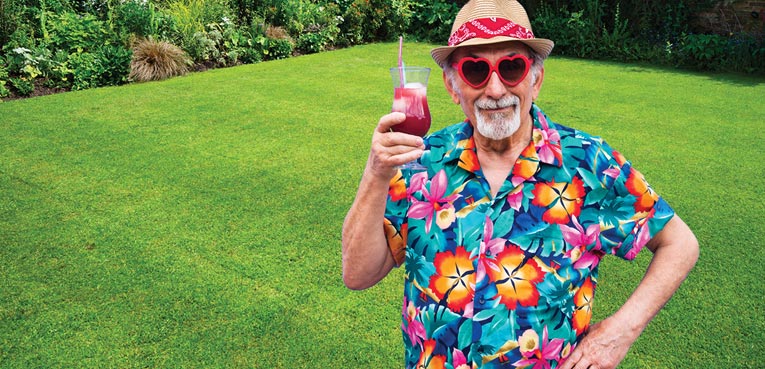Give Your Lawn Some Summer Lovin!

Summer Lawn Care
Summer is upon us! and so is summer lawn care. The temperature is increasing, and we are enjoying the outdoors, going about finding ways to cool down. It's this time of year that it's also important that we understand the effect the increased temperatures also have on our grass.
The trouble with some parts of the country during summer are extended dry periods - whilst other more tropical areas typically experience their wet season, so any advice needs to consider your current weather pattern circumstances.
Changing a few little things now will help to ensure your lawn gets through the summer heat as best it can.
- Summer is the peak growing period for most Australian lawn types
- Regular deep watering is better for your lawn than frequent shallow watering
- Regular mowing will be better for your lawn in extended dry periods
The key to keeping your lawn in top condition right through summer is a combination of the right lawn type coupled with the appropriate amount of irrigation and care. Regular deep watering to encourage a stronger and deeper root system and an occasional nutrient boost with a high quality, lawn fertiliser application will help to keep your lawn in top shape for summer. The healthier the lawn, the less susceptible to weeds or disease it becomes and allows it to better withstand any long hot-and-dry-spells that may be soon headed our way.
When should I water my lawn?
Conserving water and getting the most benefit out of the water you do use, is the most important aspect of summer lawn care. Watering in the heat of the day will cause a lot of moisture loss due to evaporation. Watering your lawn in the morning or evening, will better allow the water to be absorbed and limit the amount of water lost to evaporation. If you experience humid conditions overnight, it's best to water in the morning only as evening watering can lead to disease issues. It is also important to make sure you follow local water restrictions if there are any in place.
If there's been a dry spell and the lawn has not been watered and you notice it looking a touch lacklustre, check to see if your soil is water repellent. You can do this by pouring some water onto a few areas. If it doesn't soak in quickly, the soil may have developed hydrophobia. Wath the video below to learn about soil wetting agents that can help improve the water absorption ability of your lawn.
Mowing Principles
The key to your lawn mowing in summer is to make sure you are doing so regularly. You want to keep on top of the leaf growth, so you don't remove too much at a time. Removing more than a third of the leaf at any one time, will cause stress to the grass roots. Minimising the amount of stress that is caused to the turf is especially important at this time of year. There is some evidence that states leaving a longer leaf on your lawn is better in some summer for your lawn to manage the heat, but there is also evidence to the contrary stating that a short leaf will result in less moisture loss. We recommend sticking to the length your lawn is accustomed to, and the length that you prefer. But don't cut it so short as to scalp it or cut off excessive amounts of the leaf at any one time.
When mowing, do so earlier in the day or as the sun has started to go down again. The hot sun in the middle of the day is more likely to do damage to the freshly cut lawn, so doing so when it is cooler will cause less stress to the leaf.
In addition, a sharp set of mower blades will cut much cleaner and also reduce harm and stress to the grass, so make sure you have checked the blades and have replaced or sharpened them if necessary.
Key tips:
- Aeration - Improving the ability for water to penetrate to the roots will be important to take best advantage of water when it is available, but also to improve moisture in the soil where it is needed during the next dry spell.
- Stay off the lawn - Your grass is already having a hard time and the drier it is, the more it is likely to be damaged and not be able to recover from foot traffic or additional wear.
- Water effectively - When you can water, do so for longer, less frequently. Encourage deeper roots that can delve deeper into the soil to find moisture. This will allow your lawn to stay hydrated for longer, even if there has been an extended period without rain.
- Apply a wetting agent - Hydrophobic soil is caused by the decomposition of organic matter, which leaves a wax like substance forming a coating on soil particles. A wetting agent like Lawn Soaker will break down this coating allow water to penetrate.
- ColourGuard Plus - If your lawn has lost some colour and vigour from the heat, a good option is ColourGuard Plus. It's a natural pigment with a liquid fertiliser and it's a great solution during drought conditions to keep your grass green and to save water at the same time.
Grass Types
Choosing the right lawn type is one of the main factors in how it will perform over summer and a drought tolerant, warm season turf type like TifTuf Hybrid Bermuda (couch) or Sir Walter DNA Certified Buffalo, are the perfect turf types that will handle a harsh Aussie Summer.
For more information on these turf varieties or for contact details of your local accredited turf supplier click here.

